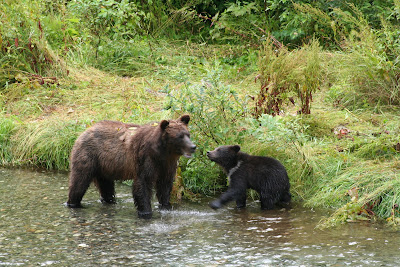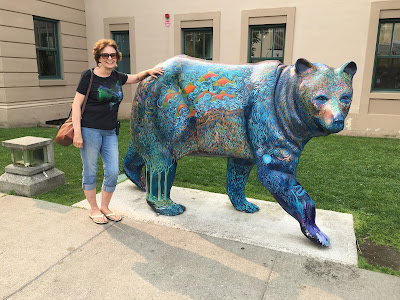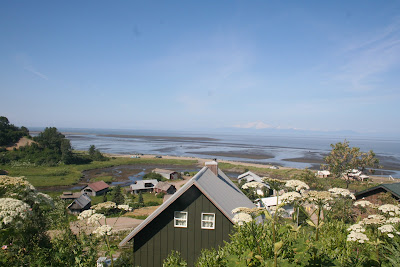Dawson City in Canada's Yukon Territory, is famous as the site of the Klondike Gold Rush. Gold was discovered there August 1896 and what ensued was pure mayhem! An estimated 100,000 people tried to make their way to Dawson between 1896 and 1899. Around 30,000 did make it to the Klondike gold fields but very few found their fortune in gold. It's a fascinating bit of history that the US shares with Canada as many of the prospectors came from the lower 48. Here's a
Wikipedia link if you're curious to know more about it.
For the next leg of our trip we will be visiting areas where the stampeders traveled to reach the Klondike.
Dawson City is on the banks of the Yukon River and the stern-wheeler was an important method of transportation. Today the stern-wheelers are merely ghost ships abandoned along the banks of the Yukon. This photo is from the stern-wheeler grave yard. There are 7 ships abandoned there but this is the only on recognizable. We were here in 1996 and I seem to remember that we saw 3 recognizable ship carcasses.
This is a stern-wheeler in Dawson City that has been preserved and it is receiving a face lift in this photo.

The Klondike Gold Rush lasted 3 short years and after that, most of the prospectors moved on, some to Nome, some returning home and some remaining in Dawson making their fortunes in the trades and mercantile businesses.
12 - 15 years later the gold dredges came to Dawson City and forever altered the landscape. Gold dredges were behemoth machines designed to dig to bedrock and capture and separate gold from the bedrock. The gold dredging operations lasted into the early 60's and then disappeared as gold mining was not economical. At that time the price of gold was controlled and was just $35 oz. Gold prices have since been deregulated and are currently at $1426.90 per ounce.
This is Gold Dredge # 4 outside Dawson City. This is the largest dredge used in the Klondike and is one of about 24 used in the region.

The dredges left behind mounds of rock suitable for growing nothing and Dawson City's landscape illustrates the environmental ugliness left behind by the gold dredges. Below are two photos of the landscape around Dawson City showing the mounds of bed rock left behind. These rocks are known as tailings and they form snake like piles of rock all over the Dawson City/Klondike River area.
Aerial view of the tailing piles - these are the snakelike ribbons you see in this photo.
We visited Bear Creek Gold Camp which was a unit designed to support the dredges and perform the final refinement of gold into gold bars. Bear Creek is operated by the Canada Parks system and is fascinating as there are so many artifacts to see, everything from machinery to account books.
This photo was taken beside as very large machine shop and these trucks were part of the operation. Of course, Dick loved the old trucks!
Another fun thing about Dawson City is that there is no bridge over the Yukon River and you have to take a ferry to continue your journey. The ferry is free and runs all during the day and night.
If you are a fan of the TV show, Gold Rush, you might recognize the barge on the left in the photo below. It belongs to Tony Beets and has been shown on the TV show. The ferry is the vessel with the orange hull while the barge is pulled up on the shore.

Driving in Alaska & the Yukon
For the most part the roads have been good and we have encountered very little road construction as compared to all the construction we encountered in 1995 when we moved to Alaska. At that time, they were still rebuilding sections of the Alaska Highway. However, there is a section of road known as the Tok cutoff and that road is AWFUL!!! In places the road surface along the side is completely gone and the frost heaves are terrible. Frost heaves occur when road is constructed over permafrost (permanently frozen ground). The road surface attracts and holds heat, thereby causing the permafrost to melt, thus creating dips, waves and heaves in the road surface. Trust me, you better slow down when going over these frost heaves!
Can you see the buckles in the road in this photo? Those are frost heaves, SLOW DOWN!

This is a photo Dick took along the Klondike Highway. The road is very narrow and there are no shoulders and wow, look at the drop off. Yikes, better pay attention! I was just hoping a moose or bear did not step out of the brush along the highway in front of us!!

On to Skagway, AK next where many of the gold rush prospectors entered Alaska on their way to the gold fields in Canada's Klondike.
















































